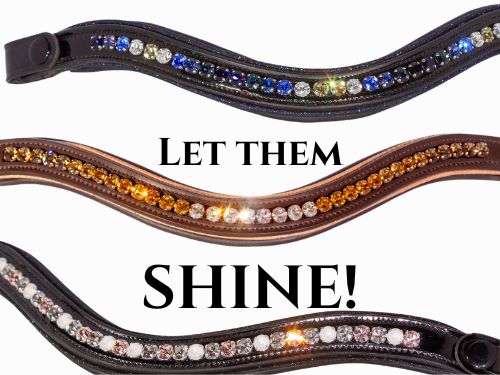
by LaceyKnight | Mar 14, 2025 | Horses, Inspiration
A few days ago, I posted a blog about quality and price versus one of my competitors. It was in poor taste, and while I had a feeling about it before posting it, the advice of the person I asked was to “Go for it.” And so I did. It wasn’t in alignment, and I should have known better.
I think it’s easy to become so enamored with what someone else is doing and compare yourself to them, especially if you envy their game. I have been suffering the route of envy and fully paying the price.
I also want to add that I say this other business is “my competitor,” but I am not yet in the same arena as them. In fact, at this juncture, I’m nowhere even on the same show grounds. However, I have set my sights high with a goal in mind and a desire to honor the horses and their beloved people, and I will continue to aim high.
To anyone I offended or who felt targeted in my blog, I apologize. They say imitation is the most sincere form of flattery, but I would argue this is not imitation; I have been fully inspired by what they are doing, and they have broadened my horizons when it comes to what is possible with equine fashion and design. Thank God they have paved the way for me to follow in their hoofprints.
To anyone reading this, thanks for letting me be human and learn as I go. There are no rule books in this game…that I know of…except what my gut tells me. I will seek to further follow my gut instead of the opinion of others. Lesson learned.

by LaceyKnight | Feb 13, 2025 | Horses, Leather goods
For as long as humans have worked with horses, different forms of bridles have been used to communicate and guide them. The bitless bridle is not a modern invention but a practice with deep historical roots. From ancient civilizations to today’s equestrian world, it has played an essential role in horse training and riding, offering a gentle, more equine-centric alternative to traditional bitted bridles.
The Historical Use of Bitless Bridles
Early horsemen used variations of the bitless bridle long before the widespread adoption of metal bits. Ancient cultures, including the Persians, Native American tribes, and Mongolian warriors, relied on rawhide, braided rope, or leather headgear that applied pressure to the nose and poll to communicate with their horses. These designs allowed for effective control without the potential discomfort or damage caused by metal bits.



During the Middle Ages, knights often rode with hackamores—a type of bitless bridle that uses nose pressure for guidance. In regions where precision and harmony with the horse were crucial, riders refined bitless designs to create subtle yet effective means of control.
Why the Bitless Bridle Matters Today
In modern equestrian disciplines, bridles without bits have seen a resurgence, particularly among riders who prioritize horse comfort and natural horsemanship. Here’s why they continue to gain popularity:
- Horse Welfare: A bitless bridle eliminates pressure on the mouth, reducing the risk of discomfort, pain, or injury to the tongue, bars, and palate.
- Versatility: Suitable for various disciplines, including dressage, endurance riding, and trail riding, the bitless bridle offers an effective alternative for riders seeking a gentler form of communication.
- Encourages Trust and Connection: Riding with a bitless bridle fosters a deeper bond between horse and rider, relying on seat, leg, and rein cues without the need for a metal bit.
- Ideal for Sensitive Horses: Some horses have dental issues, past trauma, or naturally soft mouths that make a bitless bridle a more comfortable option.
The Future of the Bitless Bridle
As awareness of equine welfare continues to grow, more riders and trainers are exploring the benefits of going bitless. While traditional bitted bridles remain common, advancements in bitless designs provide riders with options that align with their horse’s needs and riding goals. Whether used for daily riding, competition, or rehabilitation, the bitless bridle is proving to be a timeless and valuable tool in the equestrian world.
Stay tuned for the big reveal of our Envisioned Bitless Bridle! Coming Spring 2025.
Want the perfect browband to go with your bitless bridle? Find them here.
Not yet ready to go bitless?
Want a basic overview of the history of tack in general? Go here.

by LaceyKnight | Feb 12, 2025 | Browband, Horses, Leather goods
A rhinestone browband isn’t just an accessory—it’s a way to express your style while complementing your horse’s natural beauty. But with so many colors, shapes, and styles available, choosing the perfect one can feel overwhelming! This guide will help you find the ideal rhinestone browband based on your horse’s coat color, your riding discipline, and your personal style.
1. Match the Browband to Your Horse’s Coat Color
Certain colors enhance your horse’s natural tones, making their features pop! Here are some general guidelines:
- Dark Bay & Black Horses: Jewel tones like emerald green, sapphire blue, or rich burgundy stand out beautifully. Metallics like gold and silver also add a striking contrast.
- Chestnut & Red-Toned Horses: Warm tones like amber, copper, or champagne complement their coats. Deep blues and greens can create a bold contrast.
- Grey & White Horses: Almost any color works, but pastels, cool blues, and deep purples look especially elegant.
- Palomino & Buckskin Horses: Earthy tones like bronze, topaz, and soft rose gold enhance their golden hues.
2. Consider Your Riding Discipline
Your choice of rhinestone browband should align with your riding style and competition rules:
- Dressage Riders: Bold, elegant designs with larger stones or intricate patterns add a touch of refinement.
- Hunter/Jumper Riders: Classic, subtle bling works best—opt for neutral tones or a single-row design for a polished look.
- Eventers & Trail Riders: Go as bold as you like! Vibrant colors and unique patterns let you showcase your personality.
3. Reflect Your Personal Style
A rhinestone browband is an extension of your personality! Ask yourself:
- Do you prefer subtle elegance? Try a single-row browband with neutral or metallic stones.
- Love bold, eye-catching bling? Go for wave designs with contrasting colors and bright rhinestones.
- Want a theme or special meaning? Some browbands feature patterns or colors inspired by just about anything and everything. Read product descriptions to learn more about each one!
4. Prioritize Quality and Fit
A well-made rhinestone browband should be both stunning and durable. Look for:
- Strong stitching and high-quality leather for longevity.
- Securely set rhinestones that won’t fall out after a few rides. All of our stones are hand-set to ensure their security so you can enjoy them, ride after ride!
- A comfortable fit—ensure it sits properly on your horse’s forehead without pinching. Need help finding the perfect fit?
Final Thoughts
Choosing the perfect rhinestone browband is about balancing color, discipline, and personal style while ensuring comfort and durability. Whether you go for classic elegance or bold sparkle, the right browband will make both you and your horse shine in and out of the arena!
What’s your go-to browband style? Share your favorites below!

by LaceyKnight | Feb 12, 2025 | Browband, Leather goods, Tack care
A rhinestone browband is more than just an accessory—it’s a statement. Whether you love bold, flashy designs or elegant, subtle sparkle, a well-maintained browband enhances your horse’s look and ensures your tack stays in top shape. But let’s be real—dust, sweat, and everyday riding can dull that shine. So, how do you keep your rhinestone browband looking brand new? Here’s everything you need to know!
1. Regular Cleaning: Wipe Away the Dust and Grime
Your rhinestone browband picks up dust, sweat, and barn dirt faster than you think. To prevent buildup:
- After each ride, use a soft, dry cloth to wipe away any surface dust.
- For deeper cleaning, dampen a microfiber cloth with water or a mild leather cleaner and gently wipe the leather and rhinestones.
- Avoid soaking the browband—excess moisture can loosen stones over time.
2. Use the Right Cleaning Products
Not all cleaners are created equal! To preserve both the leather and the sparkle:
- Use a gentle leather cleaner for the browband itself—harsh chemicals can dry out or discolor leather.
- For rhinestones, a tiny drop of mild dish soap diluted in water works wonders. Apply with a soft toothbrush or cotton swab to get into the crevices without scratching the stones.
- Never use alcohol-based cleaners or abrasive pads—these can damage the shine and loosen the settings.
3. Store It Properly
Proper storage prevents unnecessary wear and tear:
- Keep your rhinestone browband in a soft cloth bag or padded bridle rack when not in use.
- Avoid tossing it into a tack trunk where it can rub against other gear and get scratched.
- Store in a cool, dry place—excess humidity can weaken glue settings, while extreme heat can cause leather to crack.
4. Handle with Care
Rhinestones add undeniable glamour, but they’re delicate!
- Avoid dropping or bending your browband, as this can loosen or dislodge stones.
- Be mindful when adjusting your bridle to avoid tugging on the rhinestones or pressing them against hard surfaces.
- If you notice a loose stone, secure it with a tiny dab of jewelry glue, or take it to a professional for repair.
5. Give It a Professional Refresh
Even with the best care, rhinestones can lose some of their brilliance over time. If your browband needs a little extra TLC:
- Take it to a leather specialist for professional cleaning and conditioning.
- If stones become dull or missing, consider a custom replacement or upgrade to keep your browband looking as dazzling as the day you got it.
Final Thoughts
Your rhinestone browband is meant to shine—so keeping it clean and well-maintained ensures it stays the centerpiece of your horse’s bridle. With these easy care tips, you’ll keep your browband sparkling ride after ride!
How do you keep your tack looking its best? Share your favorite care tips!
In the mood for some sparkle? View our rhinestone browbands here.

by LaceyKnight | Feb 2, 2025 | Browband, Horses
You’ve spent countless hours online scrutinizing colors, patterns, brands, and sizes. But it’s coming down to the wire. It’s time to choose your horse’s browband. Like most people, you have probably taken into consideration what would look the best, but what if you could get a browband that conveys something about your horse’s unique personality?
Dreaming of Dragons
We have a browband called Dreaming of Dragons. It features one color of crystal on a black leather, wave-shaped band. The crystals are dark and broody, but they flash colors like yellow, lime green, magenta, purples, and blues. It’s one of those all-encompassing crystals that carries all the colors of the rainbow, only to allow them to pop under the right conditions. It’s absolutely beautiful.
But does this browband mean your horse must have “dragon status” in order to wear it? We think not. This browband is for horses with multi-faceted personalities, ones that shine under the right conditions and who may need a little encouragement, light, and love to sparkle their brightest.
Just like the dragons of myth, some horses possess an undeniable presence—powerful, mysterious, and full of depth. Others hold their brilliance quietly, revealing their fire only when the moment is right. Dreaming of Dragons is more than just a browband; it’s a statement piece for the horse who has layers, who may appear dark and brooding at times but holds an entire spectrum of light within.
Whether your horse commands attention with confidence or needs a little nurturing to reveal their inner glow, this browband is a reflection of the beauty that lies beneath the surface, waiting for the perfect moment to shine.
Fade to Black
Our Fade to Black browband is pretty much the opposite of Dreaming of Dragons. On black leather with black sparkle piping, you’ll find an ombre pattern with riveting black crystals in the center, slowly fading to silver and then bright white on either side.
This browband means the horse is straightforward, always on, always shining. Fade to black is no frills, which suggests that the horse has talent enough to cover the simplicity of the design with their own unique flair. This browband is perfect for those with horses who don’t need a lot of color to wow in the ring and who have no problem coming back down when it’s time to leave the arena and just be ‘horse and human’ again.
Fade to Black is for the horse that doesn’t need embellishment to make an impression—the one whose presence alone is enough. It’s a nod to the partnership between horse and rider, where skill, connection, and quiet confidence speak louder than any bright colors ever could. Whether they’re lighting up the arena or standing peacefully at your side, this browband complements a horse that carries their own natural brilliance, effortlessly transitioning between performance and partnership.
Carnaval
At the opposite extreme is Carnaval. We almost need not write anything about this one because it speaks for itself. Based on Brazil’s colors and the annual festival they have, Carnaval is its own celebration of light, vibrancy, and all things flashy.
If your horse is wearing Carnaval, they have an inner light that is impossible to dampen. They are bright, alert, slightly wild at times, and may have a hard time coming back down once they leave the ring. Horses wearing Carnaval have lots of personality and the moves to back it all up…even if they aren’t moves in the desired direction.
Carnaval is for the horse that turns every moment into a performance, the one who thrives on energy and excitement. They don’t just enter the arena—they make an entrance. With a spirit that refuses to be contained, this browband is a tribute to the horses who bring joy, brilliance, and a touch of chaos wherever they go. If your horse wears Carnaval, they aren’t just along for the ride—they are the celebration itself.
The Turquoise & Terracotta Browband
Turquoise and Terracotta is somewhere near the middle of the spectrum in terms of flashiness. It features bright turquoise stones along with vibrant padparadscha, golden honey, and special rondelles that also feature padparadscha surrounded by bright turquoise to match.
This browband is beautiful, yet it doesn’t scream high-performance jumper, dressage horse, or eventer at heart. It has a relaxed and softer vibe, which does say, “I’m a hunter who likes my work” Or “I take care of people on the trail, but I look fabulous while doing it.” This horse will be relaxed, an absolute sweetheart, and generous to their human companions in every way.
Turquoise and Terracotta is for the dependable partner—the horse that carries themselves with quiet confidence and effortless grace. They may not demand the spotlight, but their presence is undeniably felt. This is the horse that greets you at the gate, takes care of their rider, and moves through life with a steady, kindhearted spirit. They appreciate the finer things, but above all, they value connection, trust, and the simple joy of the ride.
The Phoenix Browband
One of our favorite browbands, the Phoenix, is yet another example of a browband that might match a horse’s story along with their personality. Rising from the ashes, this browband would be great for rescue horses who proved everyone wrong once they found the right home or horses who have overcome injuries or illness to come back and take the world by storm.
It’s flashy, but just the right amount, suggesting your horse is humble yet knows his or her worth. It’s just the right mix of “Let me show you what I’ve got” and “I am well aware of what I’ve got, and I don’t need to flaunt it.”
The Phoenix browband is for the horse that has faced challenges and come out stronger, wiser, and more radiant than ever. This is the partner that has nothing to prove but everything to give—a horse that carries their past with quiet dignity and embraces their future with fire in their heart. Whether they’ve overcome adversity or simply embody resilience and grace, this browband reflects their journey, their strength, and the undeniable brilliance that was always within them.
At the End of the Ride…
Whether you choose a browband that simply exemplifies your favorite color/s or you want something that matches your horse’s particular storyline, we hope that you can see that each and every browband does, in fact, share a little bit about the horse behind the leather.
We encourage you to go with your intuition, listen to your gut, and reflect upon why you might have chosen a specific browband if it’s not altogether obvious upfront.
In celebration of horses everywhere.
Sincerely,
Envisioned Equestrian








